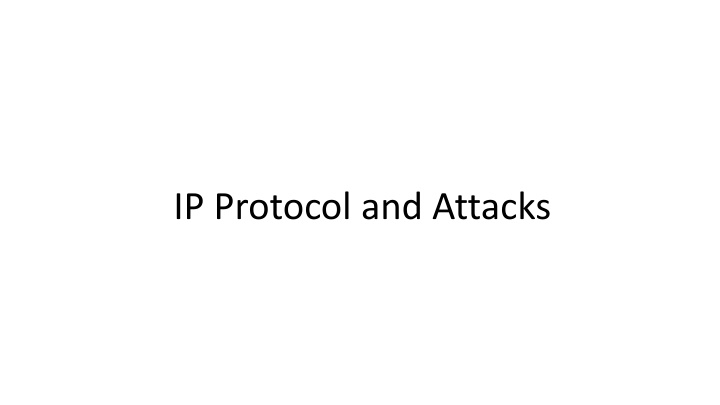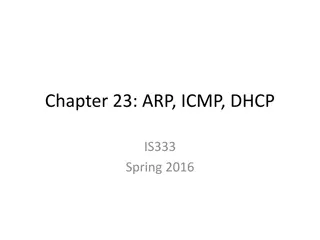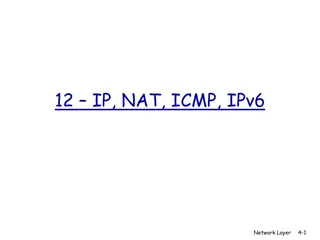
IP Protocol, Fragmentation, and Attacks
Explore the world of IP protocol and attacks with detailed insights on the IP layer, header, fragmentation, routing, ICMP, and more. Learn how IP fragmentation works, the importance of TTL in traceroute, and how to implement traceroute effectively. Discover the significance of packet traversal, the need for fragmentation, and the vulnerabilities related to attacks on IP fragmentation.
Download Presentation

Please find below an Image/Link to download the presentation.
The content on the website is provided AS IS for your information and personal use only. It may not be sold, licensed, or shared on other websites without obtaining consent from the author. If you encounter any issues during the download, it is possible that the publisher has removed the file from their server.
You are allowed to download the files provided on this website for personal or commercial use, subject to the condition that they are used lawfully. All files are the property of their respective owners.
The content on the website is provided AS IS for your information and personal use only. It may not be sold, licensed, or shared on other websites without obtaining consent from the author.
E N D
Presentation Transcript
Outline The Role of the IP layer IP Header IP Fragmentation and Attacks Routing ICMP and Attacks
Functions and Properties of IP Layer Basic functions Routing Passing packets to the transport layer Provide error detection and diagnostic capability Properties Best effort delivery Not responsible for reliable transmission
TTL and How Traceroute Works TTL = 1, 2, 3, At each router: TTL -- Packet discarded and trigger ICMP when TTL=0
The Need for Fragmentation Limit of packet size
How IP Fragmentation Works Flags bit 0: reserved, must be zero bit 1: Do not Fragment (DF) bit 2: More Fragment (MF). MF=0 for last fragment, 1 for others Offset The actual offset divided by 8 (think about why?)
Example Packet ID field: 1000 Payload size: 100 bytes Break into 3 fragments, each with at most 40 bytes of payload
Build Fragments Manually (1) Fragment 1 Fragment 2
Build Fragments Manually (2) Fragment 3 Execution Result
Attack 1: Tie Up Target's Resources Question: Can you use a small amount of bandwidth to tie up a target machine's significant amount of resource? Hint: use 2 small packets to cause server to allocate 60KB of RAM
Attack 2: Create a Super-Large Packet Question: Can you create an IP packet that is larger than 65,536 bytes? (The Ping-of-Death Attack)
Attack 3: Create Abnormal Situation Question: Can you create some abnormal conditions using "offset" and "payload size"? (Teardrop Attacks)
Routing Rules Question: What interface will be used to route packets to (1) 192.200.60.5? (2) 192.168.30.5? (3) 192.168.60.5? Routing Entry A: 0.0.0.0/0 dev interface-a B: 192.168.0.0/16 dev interface-b Packet 1 Packet 2 Packet 3 C: 192.168.60.0/24 dev interface-c D: 192.168.60.5/32 dev interface-d
Changing Routing Table $ sudo ip route add 192.168.60.0/24 dev enp0s3 via 10.0.2.7 $ sudo ip route del 192.168.60.0/24 $ ip route
How Are Routing Tables Configured For routers Routing protocols, OSPF, BGP, etc. For hosts DHCP Using default routers Manual configuration ICMP redirect messages
ICMP: Internet Control Message Protocol Send Error messages Send Operational information
ICMP Echo Request/Reply Used by ping Type 8: request 0: reply
Smurf Attack Direct broadcast address Example: 192.168.60.255 for network 192.168.60.0/24
ICMP Time Exceeded Type: 11 Code: 0: Time-to-live exceeded in transit 1: Fragment reassembly time exceeded TTL=10
ICMP Destination Unreachable Type: Code 0: Destination network unreachable 1: Destination host unreachable 3: Destination port unreachable
ICMP Redirect Experiment: Setup Make 10.9.0.11 the default router 10.9.0.11 s default router is 10.9.0.1
ICMP Redirect Experiment 10.9.0.5 can directly send to 10.9.0.1: trigger ICMP redirect After redirection (check 10.9.0.5)
Spoofing ICMP Redirect Message Attack result
MITM Attack By Spoofing ICMP Redirect Redirect traffic to attacker s machines Make changes before sending the packets out Similar to the MITM attacking using the ARP cache poisoning attack
Question: ICMP Redirect Question 1: Can you launch ICMP redirect from a remote computer? Question 2: Can you use ICMP redirect attacks to redirect to a remote computer?
Summary The Role of the IP layer IP Header Routing ICMP








